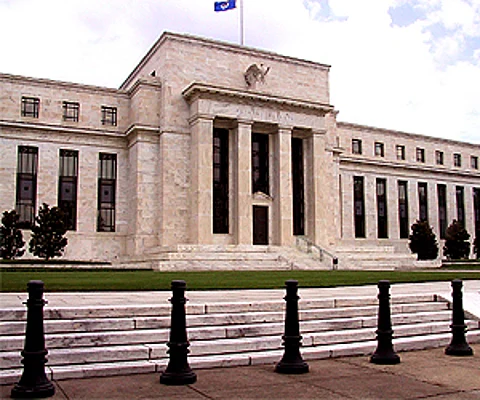

Alan Greenspan, who understands the intricate interplay of reason and emotion influencing financial markets, once observed that “Fear is a far more dominant force in human behaviour than euphoria.” On Friday, indices on the US stock market tumbled — the Dow fell by over 900 points. Worse, the projections of the futures segment over the weekend suggest a bloody Monday for stock markets across the globe. Forecasts for every major index — Nikkei, Hang Seng, Nifty50, FTSE, DJIA, NASDAQ, S&P et al — are bathed in red.
It can be safely said that the old adage ‘there is no free lunch’ has come home to roost. For two years, the developed economies led by the US created money like there was no tomorrow — between the arrival of the virus and the vaccination, G7 economies had poured an estimated $ 9 trillion to sustain financial stability and to stimulate the economy. In the process, the US Federal Reserve had expanded its balance sheet to $ 9 trillion and was buying over $ 120 billion of issuances including junk bonds in a seductively titled nomenclature of ‘’fallen angels’’.
The phraseology deployed by the US Federal Reserve in its official stance was that inflation was ‘transitory’. By the time Fed Chairman Jerome Powell ‘retired’ the phase in February, inflation had touched 7.9 per cent and in April, it recorded a 40-year high of 8.5 per cent. The fear now is that from the illusion of transitory inflation the global economy is sliding into a space where growth is transitory!
The transition of the US Fed from dovish to hyper hawkish is stunning. This Thursday, Powell indicated that a 50 basis points hike in rates is on the table. This has triggered calls for steeper hikes. While financial service giant Nomura expects hikes of 50, 75 and 75 basis points in May, June and July, Citibank expects four hikes of 50 basis points each between May and August. Effectively what would have come through in ten months is now being compressed in three-four months. Almost every central bank is poised to end stimulus packages and hike rates, and this will have a significant bearing on the cost of money. The shock induced by sudden hike of rates by the US Fed will constrain liquidity and worsen credit risks.
The IMF, in its latest outlook, has laid out a grim scenario in a detailed analysis of previous episodes of quantitative tightening: “Surprise tightening, particularly in the US, has been associated with capital flow reversals from emerging market and developing economies, widening spreads, currency depreciations, and tighter external financial conditions”. The implications of steeper ‘front loaded’ rate hikes, particularly in the light of the slowing of China’s economy and the consequences of the Ukraine invasion, is grave for India and the developing world.
The rising cost of capital will impact consumption, global trade and growth. India is as yet the fastest growing large economy — and that matters — but the emerging circumstances present some serious challenges. India’s good news story of booming exports and ambitions to ramp up service exports is vulnerable to slowdowns in the developed world. Rise in interest rates typically triggers a flight to safety and returns. Already foreign portfolio investors have been selling off — FII sales add up to over `29,000 crore in April alone. India is a net importer of petroleum products and this could worsen the hit on the rupee. It is true that India’s forex reserves afford a buffer but the RBI has already spent over $ 30 billion to curtail volatility and to stabilise the currency. Further interventions are subject to the statute of limitations.
The gross borrowings of India’s states and the union government is expected to be around Rs 23 lakh crore. India’s debt GDP ratio shot up post the pandemic to 90 per cent of GDP and is now at 86 per cent. The fiscal balance is scaffolded by the ambitious plan to monetise assets and disinvestments. The LIC listing would come up for review if the slide in stock markets is deep and sustained. The idea of crowding in private investment via public expenditure will again be influenced by the cost of capital. Sure tax collections have been higher, but so are allocations for welfare expenditure.
India is better positioned than most economies, but its balances as always are fragile and vulnerable. Neuro psychiatrists will tell you that stress is not located in what happens but how the entity responds to what happens. There are opportunities to tap for investments leveraging the developed world’s quest for resilient supply chains and the hunger of global funds focussed on ESG. There is room to expand trade and calls for expansion of FTAs and improved economic engagement with the consumers of the world. The moot question is can India’s policy makers be humble and nimble.
Economic outcomes are defined by the choices in policy and expectations. The US has signalled the end of free lunch. The crux is who is paying. The excesses of the developed world have come to haunt the developing world. And the worst hit will be the economies at the bottom of the pyramid. It is useful to remember that rate hikes are not a silver bullet. The spectre of inflation is not going away anytime soon. The drivers of inflation are governed by externalities such as sanctions, pandemic and supply chain disruptions. Fasten the seatbelts for the rough ride ahead.
Shankkar aiyar
Author of The Gated Republic, Aadhaar: A Biometric History of India’s 12 Digit Revolution, and Accidental India shankkar.aiyar@gmail.com